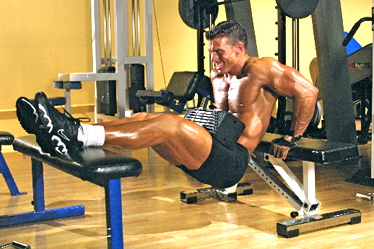It’s a very common exercise. We frequently see it done in weight rooms and aerobic classes, and it’s regularly demonstrated in fitness books and magazines. It only requires a bench (or two benches), or a STEP – and some people even add resistance by stacking barbell plates on their legs (with someone’s assistance, of course). The goal is – ostensibly – to work the triceps muscle. But does it ?
As with any exercise, we begin evaluating this one with some basic physics principles. In analyzing any exercise, one of the most important questions to ask ourselves is this: does the lever, which is operated by your target muscle, cross resistance?
In this case, your target muscle is the triceps. The triceps operates the forearm lever – meaning that it moves the forearm lever, by extending the elbow (note: the forearm lever is also operated by the biceps, but in the opposite direction).
So here’s the initial question phrased a bit more specifically: does resistance (gravity, in this particular case, since there is no pulley or machine being used) cross the forearm lever? Does the forearm lever interact perpendicularly, with gravity, during Bench Dips? Answer: essentially – no. Throughout the movement – whether you are in the “up” position, or in the “down” position – the forearm is almost entirely parallel to gravity. A lever that is perfectly parallel to resistance is neutral, which means that the muscle that operates that lever is mostly unchallenged.
When you observe someone performing Bench Dips, you’ll notice that the upper arm lever does cross resistance. A lever that crosses resistance is active, which means that the muscle that operates that lever is being fully loaded by the resistance. During Bench Dips, it is the frontal deltoid that is doing most of the work, because it is the muscle mostly responsible for operating the upper arm lever in the pathway of this particular movement. However, most people have no intention of working their frontal deltoid when doing Bench Dips. And worse, this particular movement works the frontal deltoid through its riskiest range of motion – the extreme stretch.
So, while most people do Bench Dips with the intention of working their triceps, they are getting very little triceps benefit, a significant amount of frontal deltoid work, and a considerable amount of risk to the front deltoid. There are much better triceps exercises, and there are much better (i.e., safer and more effective) frontal deltoid exercises. So the Bench Dip is actually a very poor choice of exercise. This is even more true when one is in a fully-equipped weight room, surrounded by far better options. It would be like brushing your teeth with a pencil, instead of toothbrush. And adding a wrist weight to your arm while using the pencil to brush your teeth, will not make it work any better. It’s simply not the proper tool, and neither is the Bench Dip.
To be more specific in regards to the mechanics of Bench Dips, the degree to which the forearm angles one way or the other, determines the degree (if any) of triceps involvement. For example, if the forearm angles “back” during the movement (the elbow is farther back than the hand on the bench), there will be SOME degree of triceps involvement. However, if the forearm angles “forward” (the elbow is in front of the hand on the bench), there will be very little triceps involvement. The degree of the forearm angle is largely determined by how close (or far) one is to the bench. The farther away one is from the bench, the less the triceps works, and the more the frontal deltoids work.
If we compare the mechanics of Bench Dips to either a Triceps Pushdown (with cable) or a Flat Bench Triceps Extension (with a pair of dumbbells or a barbell), you can easily see the difference. In the case of Triceps Pushdowns, the cable indicates the direction of the resistance, and you can see how the forearm lever moves “across” (perpendicularly to) the cable, during the range of motion – which is good. During the Triceps Extensions with dumbbells (on a flat bench) – again – you can see how the forearm lever crosses the downward direction of gravity at the midway point – which is very good. These two exercises are far better for the triceps than are Bench Dips.
When we see someone in the weight room, doing Bench Dips with a load of barbell plates on their legs, it may appear that they know what they’re doing, and the exercise may appear to be productive – especially if the person doing them is muscular. However, these two assumptions are not entirely accurate. As I’ve said many times before, if a person does five exercises, and one of them is mostly unproductive, they will still reap the benefit of the other four exercises. The unproductive exercise will not “un-do” the benefits of the other four. It will simply not contribute as much – if any – benefit, and it may pose a risk of injury, as well as result in wasted effort. For these reasons, I believe it would be better to skip Bench Dips (and other less-than-maximally productive and/or risky exercises), or replace them with other, more productive / less risky exercises.

Photo of Jonathan Lawson by Mike Neveux




















3 Comments
You must be logged in to post a comment Login